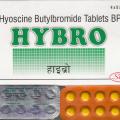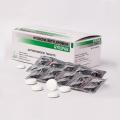Home / Categories / BUTASPAS TAB

BUTASPAS TAB
(10x10)
HYOSCINE BUTYLBROMIDE-10MG
ANTI-SPASMODIC DRUGS
BIOGAIN REMEDIES P. LTD.
Product Details
Scopolamine HBr (Hyoscine HBr)
A to Z Drug Facts
Scopolamine HBr (Hyoscine HBr)
Action
Indications
Contraindications
Route/Dosage
Interactions
Lab Test Interferences
Adverse Reactions
PrecautionsPatient Care Considerations
Administration/Storage
Assessment/Interventions
Patient/Family Education
(skoe-PAHL-uh-meen HIGH-droe-BRO-mide)Isopto Hyoscine, Scopace, Scopalamine HBrClass: Antiemetic antivertigo/anticholinergic
 Action Competitively inhibits action of acetylcholine at muscarinic receptors. Principal effects are on iris and ciliary body (pupil dilations and blurred vision), secretory glands (dry mouth), drowsiness, euphoria, fatigue, decreased nausea, and vomiting.
Action Competitively inhibits action of acetylcholine at muscarinic receptors. Principal effects are on iris and ciliary body (pupil dilations and blurred vision), secretory glands (dry mouth), drowsiness, euphoria, fatigue, decreased nausea, and vomiting.
 Indications Accomplishment of cycloplegia and mydriasis for diagnostic procedures and for preoperative and postoperative states in treatment of iridocyclitis (ophthalmic use); prevention of nausea and vomiting associated with motion sickness (transdermal); preanesthetic sedation and obstetric amnesia in conjunction with analgesics and to calm delirium (parenteral).
Indications Accomplishment of cycloplegia and mydriasis for diagnostic procedures and for preoperative and postoperative states in treatment of iridocyclitis (ophthalmic use); prevention of nausea and vomiting associated with motion sickness (transdermal); preanesthetic sedation and obstetric amnesia in conjunction with analgesics and to calm delirium (parenteral).
 Contraindications Hypersensitivity to any product component, glaucoma; adhesions between iris and lens; children with previous severe reaction to atropine.
Contraindications Hypersensitivity to any product component, glaucoma; adhesions between iris and lens; children with previous severe reaction to atropine.
 Route/Dosage
Route/Dosage
Ophthalmic
ADULTS: 1 to 2 gtt of 1% solution into eye 1 hr prior to refraction; or 1 to 2 gtt up to qid for uveitis. CHILDREN: 1 to 2 gtt of 0.5% solution into eye 1 hr prior to refraction; or 1 to 2 gtt of 0.5% solution up to tid for uveitis.
Parenteral
ADULTS: IM/SO/IV 0.32 to 0.65 mg. CHILDREN: 0.006 mg/kg (maximum 0.3 mg).
Transdermal
ADULTS: One transdermal patch placed behind ear ³ 4 hr prior to event. Wear only 1 patch at a time. Approximately 1 mg will be delivered over 3 days.
 Interactions
Interactions
Haloperidol: Worsened schizophrenia, decreased haloperidol levels, and tardive dyskinesia may occur. IV incompatibilities: Solutions are incompatible with alkalies. Phenothiazines: Actions of phenothiazines may be decreased.
 Lab Test Interferences None well documented.
Lab Test Interferences None well documented.
 Adverse Reactions
Adverse Reactions
CV: Increased heart rate. CNS: Drowsiness; disorientation; delirium. DERM: Contact dermatitis; erythema. EENT: Blurred vision; stinging; increased IOP; photophobia; conjunctivitis. GI: Dry mouth. RESP: Decreased respiratory rate.
 Precautions
Precautions
Pregnancy: Category C. Lactation: Undetermined. Children: Safety and efficacy not established for transdermal use. Use with caution in children, infants, geriatric patients, those with diabetes, thyroid abnormalities, or glaucoma. Hypersensitivity: Contact dermatitis for transdermal system has been reported. Potentially alarming idiosyncratic reactions may occur with therapeutic doses. Other: Dizziness, nausea, vomiting, headache and disturbances with equilibrium have been reported upon discontinuation after several days of use.
PATIENT CARE CONSIDERATIONS
 Administration/Storage
Administration/Storage
Direct IV
- Dilute with Sterile Water for Injection and give slowly; position patient recumbent and keep in bed for 1 hr after administration to prevent orthostatic hypotension.
Transdermal route
- Apply patch 4 hr prior to expected motion. Apply to clean, hairless, dry area behind ear. Do not touch exposed adhesive area of patch; wash hands thoroughly before and after application. Rotate application sites; place only 1 patch at a time; change patch every 72 hr.
- Store transdermal patches in packages until ready for use; note expiration date; store ophthalmic and parenteral solutions at room temperature and protect from light.
Ophthalmic route
- Wash hands before and after instillation. Position patient supine or with head tilted back in “star-gazing” position (looking at ceiling) to administer drops. Pull down lower lid to form pocket and instill solution as ordered. Avoid contact between dispenser and eye. Close eye gently and apply pressure to inner canthus for 1 to 2 min to prevent systemic absorption and drainage into nose/throat. Blot excessive solution from around eye with tissue. Wait 5 min before instilling additional ophthalmic solutions.
 Assessment/Interventions
Assessment/Interventions
- Obtain patient history, including drug history and any known allergies.
- Assess vital signs (heart rate, BP), presence of pain and intake/output ratio (watch for urinary retention) prior to and during therapy.
- Provide pain medication concomitantly as needed; remember medication alone can precipitate behavior changes such as excitation and delirium.
- Assess mouth for dryness; provide mouth care, hard candy or frequent sips of water as needed.
- Assess for blurred vision, drowsiness and dizziness; implement safety precautions (call bell, side rails) and assist with ambulation.
OVERDOSAGE: SIGNS & SYMPTOMS Somnolence, dry mouth, dilated pupils, delirium, disorientation, memory disturbances, dizziness, restlessness, hallucinations
 Patient/Family Education
Patient/Family Education
-
Oral/Parenteral/Transdermal
- Tell patient if dose is missed to take as soon as remembered, but caution against doubling doses.
- Advise patient to avoid use of alcohol or other CNS depressants (eg, sedatives, antihistamines) while taking this medication.
- Advise patient that drug may cause drowsiness or dizziness and to use caution while driving or performing other tasks requiring mental alertness.
- Explain that rinsing mouth, good oral hygiene, and sugarless gum or candy will help to counteract mouth dryness.
- Encourage medical follow-up to monitor effects of therapy.
- Instruct patient and family in correct technique for application of patches; explain that patch is waterproof and not affected by showering or bathing.
- Remind patient to wash hands before and after applying patch.
- Explain to patient that if patch is dislodged, to replace it with a new unit at a different site.
Ophthalmic Preparation
- Instruct patient to wash hands before and after instillation.
- Instruct patient and family in correct technique for instillation of drops for ophthalmic use.
- Explain that blurring of vision will decrease with repeated use of drug and to avoid hazardous activities until vision clears.
- Explain that eyes may become sensitive to light and advise patient to use dark glasses indoors and outdoors.
- Emphasize need to contact physician immediately if patient notices change in vision, eye pain, loss of sight, inability to breath, or flushing.
- Tell patient to notify physician if light sensitivity persists ³ 1 wk after medication has been discontinued.
Books@Ovid
Copyright © 2003 Facts and Comparisons
David S. Tatro
A to Z Drug Facts
Substitutes


